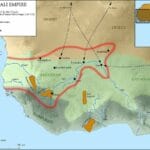Niani, a name whispered through centuries, evokes the grandeur of the Mali Empire. This isn’t just one city’s story, but two—Niani in Guinea and Niani in Gambia/Senegal. Like threads in a vibrant tapestry, their histories intertwine, forever linked to the rise and fall of one of Africa’s most powerful empires. Join us as we use maps as our guide, tracing the remnants of trade routes and uncovering the secrets held within these ancient cities.
Niani: A Lost City, Rediscovered?
Imagine a city shimmering with gold, pulsing with the energy of traders from across the world, a place where knowledge flowed as freely as the rivers that surrounded it—this was Niani, the heart of the Mali Empire. While time may have obscured its physical form, Niani’s story is far from forgotten.
More than just a dot on a map, Niani was a powerhouse, its influence radiating outward like ripples in a pond. Under the reign of Mansa Musa, whose legendary wealth still captures imaginations, Niani thrived as a beacon of cultural exchange and economic prowess. Its location, strategically placed on the banks of the Sankarani River, wasn’t just picturesque, it was the lifeblood of the empire, controlling the flow of gold and trade that fueled Mali’s rise to prominence.
But finding Niani on a modern map isn’t as straightforward as one might hope. It’s an enigma, shrouded in the mists of time, its exact location a subject of ongoing debate among historians and archaeologists. Some believe that a village in Guinea, bearing the same name, may hold the key to unlocking Niani’s secrets. Tantalizing clues, such as pottery shards and the faint outlines of ancient structures, hint at the possibility that this unassuming village rests atop the remnants of an empire.
Modern Technology: Illuminating the Past
Unearthing Niani’s secrets requires more than just shovels and brushes—it demands cutting-edge technology. Satellite imagery, with its ability to peer through layers of earth, offers archaeologists a glimpse into the past, revealing the ghostly outlines of long-forgotten structures. LiDAR, a technology that feels ripped from the pages of science fiction, uses lasers to pierce through dense vegetation, creating detailed 3D maps of the landscape below.
These technological advancements are revolutionizing the field of archaeology, allowing researchers to piece together a more complete picture of Niani’s past. Each discovery, from humble pottery shards to the foundations of grand buildings, brings us one step closer to understanding the daily lives of the people who called this city home.
Niani Today: A Village Steeped in History
Modern-day Niani, nestled in northeastern Guinea along the banks of the Sankarani River, may not be the bustling metropolis it once was, but its connection to the past is undeniable. This seemingly unassuming village carries the weight of history on its shoulders, its very existence a testament to the enduring legacy of the Mali Empire.
Niani’s location, once a strategic asset for controlling trade routes, remains geographically significant. Situated along a tributary of the mighty Niger River, it’s a poignant reminder of the city’s former glory as a hub for the exchange of goods and ideas. For approximately three centuries, Niani stood as the capital of the Mali Empire, reaching its zenith of power and influence around the 14th century. During this period, gold, salt, kola nuts, and other precious commodities flowed through its streets, enriching the empire and cementing Niani’s place in history.
While much of Niani remains buried beneath the earth, its potential for revealing the past is immense. Future archaeological digs, armed with advanced technology and a thirst for knowledge, hold the promise of uncovering more of Niani’s secrets, shedding light on the lives and customs of its inhabitants. Perhaps one day, we’ll be able to walk through its streets, marveling at its grandeur and gaining a deeper appreciation for the ingenuity and resilience of the people who made Niani a center of power and innovation.
Niani: The Capital of the Mali Empire
Niani wasn’t merely a city within the Mali Empire—it was its beating heart. For over three centuries, this powerful empire exerted its influence across West Africa, and Niani, strategically positioned on the banks of the Sankarani River, served as its political and cultural nucleus.
This strategic location, situated along vital trade routes, transformed Niani into a bustling hub, connecting the gold-rich regions of the south with the markets of North Africa. It was a crossroads of cultures, where merchants, scholars, and adventurers converged, sharing stories, goods, and ideas.
The reign of Mansa Musa marked a golden age for both Niani and the Mali Empire. His legendary pilgrimage to Mecca in 1324, a journey that showcased the empire’s wealth to the world, cemented Niani’s reputation as a city of immense riches and influence. Under Musa’s rule, Niani attracted not only traders but also some of the most brilliant minds in the Islamic world, solidifying its role as a center of learning and religious scholarship.
However, even the mightiest of empires are not immune to the tides of change. In the 15th century, raiders from the burgeoning Songhai Empire began to chip away at Mali’s power, and Niani, once thought to be impenetrable, found itself under threat. The empire began its slow decline, and by the 17th century, Niani was largely abandoned, its exact location fading into obscurity.
The search for Niani continues to this day, fueled by the desire to uncover the mysteries of this once-great city. While the present-day village of Niani in Guinea is a likely candidate for its location, definitive proof remains elusive. However, archaeologists are not deterred. Armed with modern tools and a passion for unraveling the past, they continue to seek out the remnants of Niani, hoping to piece together a more complete picture of its former glory.
Sundiata Keita: The Architect of an Empire
Before the splendor of Mansa Musa, before Niani rose to become a beacon of wealth and knowledge, there was Sundiata Keita, the visionary leader who laid the foundation for the Mali Empire’s rise to prominence. It was Keita, in the 13th century, who transformed a collection of disparate tribes into a unified force, setting the stage for Mali’s golden age.
Recognizing the importance of trade, Keita consolidated control over key trade routes, particularly those dealing in gold and salt, two of the most valuable commodities of the time. This strategic maneuver not only brought immense wealth to the empire but also established Mali’s dominance in the region.
Keita’s reign wasn’t solely focused on economic prosperity; he also fostered a culture of learning and innovation. Under his rule, architecture flourished, cities expanded, and scholars from across the region flocked to Mali, drawn by its reputation as a center of knowledge and intellectual exchange. It was this period of peace, prosperity, and intellectual growth that laid the groundwork for Niani’s eventual rise as a cultural and economic powerhouse.
Sundiata Keita’s legacy continues to resonate throughout West Africa. He is remembered not only as a skilled warrior and astute ruler but also as the architect of an empire, a leader whose vision and determination paved the way for one of Africa’s most enduring and influential civilizations.
Exploring Further
The story of Niani is far from over. It’s a story that’s still being written, each new discovery adding a brushstroke to the canvas of its history. As archaeologists continue to probe its depths, aided by cutting-edge technology and guided by the whispers of the past, we can only imagine what other secrets this ancient city holds.
If you’re interested in delving deeper into the world of maps and geography, check out this article on “Learn how to find the coordinates of coastal plain in Georgia.”
- Senior at What Age: Benefits & Eligibility Guide - March 29, 2025
- Unlocking Senior Benefits: How Old is a Senior? Your Complete Guide - March 29, 2025
- Master Russian Politeness:A Guide to Saying Please - March 29, 2025
















